Self-Similarity of Continuous-Spectrum Radiative Transfer in Plasmas with Highly Reflecting Walls
Abstract
1. Introduction
2. Materials and Methods
2.1. Basic Equations
- 2D approximation: magnetic field, B(ρ,θ), is a function of the normalized toroidal magnetic flux within magnetic surface, ρ, and of the poloidal angle, θ:
- 1D approximation: one-dimensional profile, B(ρ), is derived by averaging the field B(ρ,θ) over magnetic surface:
- 0D approximation: homogeneous profile, B = const, may be taken as Btor(R0) ≡ B0, where B0 is the vacuum toroidal magnetic field at R0 = (Rmax + Rmin)/2, or as the volume-averaged total magnetic field, <B>v:
2.2. Various Approaches to Solution of ECR Transport Problem in Toroidal Plasmas with Highly Reflecting Walls and Their Comparison
- hot Maxwellian plasma with a volume-averaged electron temperature of 〈Te〉V ≥ 10 keV;
- toroidal plasma with a noncircular cross section and moderate aspect ratio (i.e., ratio of tokamak major R0 to minor radius, a, see Figure 1) A ~ 3;
- multiple reflections of radiation from the wall of vacuum chamber.
- (A)
- A cylinder with circular cross-section, specular reflection (this case was considered specifically for the EXACTEC code, which is applicable only for this geometry, and SNECTR code, which only applied to plasma with a circular cross-section)
- (B)
- (i) A circular cylinder with diffuse reflection (this case was covered only by the SNECTR code calculations);(ii) Any (cylindrical or toroidal) geometry with diffuse reflection or a noncircular toroid with any (specular or diffuse) reflection (all these subcases may only be covered by the CYTRAN and CYNEQ codes).
- approximate spatial homogeneity of the radiation intensity, since the wave trajectories uniformly fill the plasma volume,
- approximate angular homogeneity of the radiation intensity, it is more isotropic in the angles of the wave vector in comparison with the case of specular reflection in a circular cylinder.
2.3. Similarity of Spatial Distributions of Net EC Power Loss and Spectral Distributions of Radiation Intensity
3. Results
3.1. Input Parameters for Analysis of Self-Similarity of ECR Transport
- ITER-like geometry parameters: torus major radius, R0 = 6.2 m, minor radius, a = 2.0 m, elongation, kelong = 1.9, triangularity, δ = 0.3,
- three types of the normalized temperature profile and two types of the normalized density profile, defined by the unified formula:
- a wide range of peak values of electron temperature, which includes the following values of the central temperature Te(0) = 20–55 keV (with a step of 5 keV) and fixed value of the edge temperature Te(1) = 100 eV (the respective values of volume-averaged temperature are shown in Figure 4 and Table 1 and Table 2),
- wide range of reflection coefficient values, from Rw = 0.6 to Rw = 0.9,
- three types of the profiles of the magnetic field (0D, 1D, and 2D approximations (11)–(13), calculated using the ASTRA code results for plasma equilibrium.
3.2. Self-Similarity of ECR Transport, Calculated Using CYNEQ and CYTRAN Codes
3.3. Self-Similarity of ECR Transport, Calculated Using CYNEQ, RAYTEC, and EXACTEC Codes
3.4. Analysis of Self-Similarity of Continuous-Spectrum Transport for Model Transport Coefficients
4. Discussion and Conclusions
Supplementary Materials
Author Contributions
Funding
Institutional Review Board Statement
Informed Consent Statement
Data Availability Statement
Acknowledgments
Conflicts of Interest
References
- Kukushkin, A.B.; Kulichenko, A.A.; Neverov, V.S.; Sdvizhenskii, P.A.; Sokolov, A.V.; Voloshinov, V.V. Self-similar solutions in the theory of nonstationary radiative transfer in spectral lines in plasmas and gases. Symmetry 2021, 13, 394. [Google Scholar] [CrossRef]
- Shimada, M.; Campbell, D.J.; Mukhovatov, V.; Fujiwara, M.; Kirneva, N.; Lackner, K.; Nagami, M.; Pustovitov, V.D.; Uckan, N.; Wesley, J.; et al. Chapter 1: Overview and summary. Nucl. Fusion 2007, 47, S1–S17. [Google Scholar] [CrossRef]
- Garcia, J.; Giruzzi, G.; Artaud, J.F.; Basiuk, V.; Decker, J.; Imbeaux, F.; Peysson, Y.; Schneider, M. Analysis of DEMO scenarios with the CRONOS suite of codes. Nucl. Fusion 2008, 48, 075007. [Google Scholar] [CrossRef]
- Trubnikov, B.A. Electromagnetic waves in a relativistic plasma in a magnetic field. In Plasma Physics and the Problem of Controlled Thermonuclear Reactions; Leontovich, M.A., Ed.; Pergamon Press: New York, NY, USA, 1959; Volume 3, p. 122. [Google Scholar]
- Trubnikov, B.A.; Bazhanova, A.E. Magnetic radiation from a plasma layer. In Plasma Physics and the Problem of Controlled Thermonuclear Reactions; Leontovich, M.A., Ed.; Pergamon Press: New York, NY, USA, 1961; p. 141. [Google Scholar]
- Drummond, W.E.; Rosenbluth, M.N. Cyclotron radiation from a hot plasma. Phys. Fluids 1963, 6, 276–283. [Google Scholar] [CrossRef]
- Rosenbluth, M.N. Synchrotron radiation in tokamaks. Nucl. Fusion 1970, 10, 340–343. [Google Scholar] [CrossRef]
- Trubnikov, B.A. Universal coefficients for synchrotron emission from plasma configurations. In Reviews of Plasma Physics; Leontovich, M.A., Ed.; Consultants Bureau: New York, NY, USA, 1979; Volume 7, p. 345. [Google Scholar]
- Bornatici, M.; Cano, R.; De Barbieri, O.; Engelmann, F. Electron cyclotron emission and absorption in fusion plasmas. Nucl. Fusion 1983, 23, 1153. [Google Scholar] [CrossRef]
- Cherepanov, K.V.; Kukushkin, A.B. Influence of suprathermal electrons kinetics on cyclotron radiation transport in hot toroidal plasmas. In Proceedings of the 20th IAEA Fusion Energy Conference, Vilamoura, Portugal, 1–6 November 2004; Available online: http://www-naweb.iaea.org/napc/physics/fec/fec2004/papers/th_p6-56.pdf (accessed on 3 November 2004).
- Albajar, F.; Bornatici, M.; Cortes, G.; Dies, J.; Engelmann, F.; Garcia, J.; Izquierdo, J. Importance of electron cyclotron wave energy transport in ITER. Nucl. Fusion 2005, 45, 642–648. [Google Scholar] [CrossRef]
- Kukushkin, A.B.; Minashin, P.V.; Polevoi, A.R. Impact of magnetic field inhomogeneity on electron cyclotron radiative loss in tokamak reactors. Plasma Phys. Rep. 2012, 38, 211–220. [Google Scholar] [CrossRef]
- Oosterbeek, J.W.; Udintsev, V.S.; Gandini, F.; Hirsch, M.; Laqua, H.P.; Maassen, N.; Ma, Y.; Polevoi, A.; Sirinelli, A.; Vayakis, G.; et al. Loads due to stray microwave radiation in ITER. Fusion Eng. Des. 2015, 96-97, 553–556. [Google Scholar] [CrossRef]
- Kukushkin, A.B.; Minashin, P.V.; Polevoi, A.R. Electron cyclotron power losses in ITER for 2D profile of magnetic field. In Proceedings of the 23rd IAEA Fusion Energy Conference, Daejon, Korea, 11–16 October 2010. [Google Scholar]
- Kukushkin, A.B.; Minashin, P.V.; Polevoi, A.R. Limit of electron cyclotron radiation in ITER long pulse operation. In Proceedings of the 38th EPS Conference on Plasma Physics, Strasbourg, France, 27 June–1 July 2011. [Google Scholar]
- Tamor, S. A Simple Fast Routine for Computation of Energy Transport by Synchroton Radiation in Tokamaks and Similar Geometries; SAI-023-81-189LJ/LAPS-72; Science Applications Inc.: La Jolla, CA, USA, 1981. [Google Scholar]
- Tamor, S. Calculation of energy transport by cyclotron radiation in fusion plasmas. Nucl. Technol. Fusion 1983, 3, 293–303. [Google Scholar] [CrossRef]
- Kukushkin, A.B. Heat transport by cyclotron waves in plasmas with strong magnetic field and highly reflecting walls. In Proceedings of the 14th IAEA Conference on Plasma Physics and Controlled Nuclear Fusion Research, Wuerzburg, Germany, 30 September–7 October 1992; pp. 35–45. [Google Scholar]
- Kukushkin, A.B. Analytic description of energy loss by a bounded inhomogeneous hot plasma due to the emission of electromagnetic waves. JETP Lett. 1992, 56, 487. [Google Scholar]
- Kukushkin, A.B.; Minashin, P.V. Influence of magnetic field inhomogeneity on electron cyclotron power losses in magnetic fusion reactor. In Proceedings of the 36th EPS Conference on Plasma Physics, Sofia, Bulgaria, 30 June–3 July 2009. [Google Scholar]
- Houlberg, W.A. CYTRAN 2.1; NTCC Modules Library: Oak Ridge, TN, USA, 2004. [Google Scholar]
- Albajar, F.; Bornatici, M.; Engelmann, F.; Kukushkin, A.B. Benchmarking of codes for calculating local net EC power losses in fusion plasmas. Fusion Sci. Technol. 2009, 55, 76–83. [Google Scholar] [CrossRef][Green Version]
- Albajar, F.; Bornatici, M.; Engelmann, F. Electron cyclotron radiative transfer in fusion plasmas. Nucl. Fusion 2002, 42, 670–678. [Google Scholar] [CrossRef]
- Kukushkin, A.B.; Minashin, P.V. Benchmarking of codes for spatial profiles of electron cyclotron losses with account of plasma equilibrium in tokamak reactors. In Proceedings of the 24th IAEA Fusion Energy Conference, San Diego, CA, USA, 8–13 October 2012. [Google Scholar]
- Albajar, F.; Bornatici, M.; Engelmann, F. RAYTEC: A new code for electron cyclotron radiative transport modelling of fusion plasmas. Nucl. Fusion 2009, 49, 115017. [Google Scholar] [CrossRef]
- Bekefi, G. Radiation Processes in Plasmas; Wiley: New York, NY, USA, 1966. [Google Scholar]
- Zel’dovich, Y.B.; Raizer, Y.P. Physics of Shock Waves and High-Temperature Hydrodynamic Phenomena; Academic Press: New York, NY, USA, 1967. [Google Scholar]
- Ginzburg, V.L. The propagation of electromagnetic waves in plasmas. In International Series of Monographs in Electromagnetic Waves, 2nd ed.; Pergamon: Oxford, UK, 1970; Volume 7. [Google Scholar]
- Zakharov, L.E.; Shafranov, V.D. Equilibrium of Current-carrying plasmas in toroidal configurations. In Reviews of Plasma Physics; Leontovich, M.A., Ed.; Consultant Bureau: New York, NY, USA, 1986; p. 153. [Google Scholar]
- Pereverzev, G.V.; Yushmanov, P.N.; Dnestrovskii, A.Y.; Polevoi, A.R.; Tarasjan, K.N.; Zakharov, L.E. ASTRA—An Automatic System for Transport Analysis in a Tokamak; IPP 5/42; Max-Planck-Institut für Plasmaphysik: Garching, Germany, 1991. [Google Scholar]
- Pereverzev, G.V.; Yushmanov, P.N. ASTRA—Automated System for Transport. Analysis in a Tokamak; IPP 5/98; Max-Planck-Institut für Plasmaphysik: Garching, Germany, 2002. [Google Scholar]
- Polevoi, A.R.; Medvedev, S.Y.; Casper, T.; Gribov, Y.V.; Ivanov, A.A.; Snipes, J.A.; Campbell, D.J.; Chuyanov, V.A. Assessment of operational space for long-pulse scenarios in ITER. In Proceedings of the 37th EPS Conference on Plasma Physics, Dublin, Ireland, 22–25 June 2010. [Google Scholar]
- Cherepanov, K.V.; Kukushkin, A.B.; Minashin, P.V.; Neverov, V.S. Nonlocal vs. diffusion mechanisms of electron cyclotron radiation transport in fusion reactor-grade tokamaks. In Proceedings of the 7th 34th EPS Conference on Plasma Physics, Warsaw, Poland, 2–6 July 2007. [Google Scholar]
- Tamor, S. Synchrotron radiation loss from hot plasma. Nucl. Instrum. Methods Phys. Res. Sect. 1988, 271, 37–40. [Google Scholar] [CrossRef]
- Albajar, F.; Bornatici, M.; Engelmann, F. EC radiative transport and losses in demo-like high-temperature plasmas. EPJ Web Conf. 2015, 87, 01009. [Google Scholar] [CrossRef]
- Kukushkin, A.B.; Minashin, P.V.; Neverov, V.S. Similarity of spatial distributions of net electron cyclotron power losses in fusion plasmas. In Proceedings of the 35th EPS Conference on Plasma Physics, Hersonissos, Greece, 9–13 June 2008. [Google Scholar]
- Minashin, P.V.; Kukushkin, A.B. Influence of plasma equilibrium on scaling laws for local and total electron cyclotron power losses in tokamak-reactors. In Proceedings of the 39th EPS Conference on Plasma Physics, Stockholm, Sweden, 2–6 July 2012. P4.009. [Google Scholar]
- Albajar, F.; Bornatici, M.; Engelmann, F. Electron cyclotron radiative transfer in the presence of polarization scrambling in wall reflections. Nucl. Fusion 2005, 45, L9–L13. [Google Scholar] [CrossRef][Green Version]
- Minashin, P.V.; Kukushkin, A.B. Spectroscopic diagnostics of superthermal electrons with high-number harmonic EC radiation in tokamak reactor plasmas. EPJ Web Conf. 2015, 87, 03009. [Google Scholar] [CrossRef]
- Sdvizhenskii, P.A.; Minashin, P.V.; Kukushkin, A.B.; Kurskiev, G.S.; Mukhin, E.E. Complex diagnostics of electron velocity distribution with thomson scattering and electron cyclotron emission in tokamaks. In Proceedings of the 42nd EPS Conference on Plasma Physics, Lisbon, Portugal, 22–26 June 2015. [Google Scholar]
- Prater, R.; Farina, D.; Gribov, Y.; Harvey, R.W.; Ram, A.K.; Lin-Liu, Y.-R.; Poli, E.; Smirnov, A.P.; Volpe, F.; Westerhof, E.; et al. Benchmarking of codes for electron cyclotron heating and electron cyclotron current drive under ITER conditions. Nucl. Fusion 2008, 48, 035006. [Google Scholar] [CrossRef]
- Minashin, P.V.; Kukushkin, A.B. Algorithm of self-consistent calculation of EC losses and kinetics of ECRH/ECCD in Tokamak-reactors. In Proceedings of the 40th EPS Conference on Plasma Physics, Espoo, Finland, 1–5 July 2013. [Google Scholar]
- Smirnov, A.P.; Harvey, R.W.; Kupfer, K. A general ray tracing code GENRAY. Bull. Am. Phys. Soc. 1994, 39, 1626. [Google Scholar]
- Harvey, R.W.; McCoy, M.G. The CQL3D code. In Proceedings of the IAEA Technical Committee Meeting on Advances in Simulation and Modeling of Thermonuclear Plasmas, Montreal, QC, Canada, 15–17 June 1992; pp. 489–526. [Google Scholar]
- Albajar, F.; Bornatici, M.; Engelmann, F. EC radiative transport in fusion plasmas with an anisotropic distribution of suprathermal electrons. In Proceedings of the 16th Joint Workshop Electron Cyclotron Emission and Electron Cyclotron Resonance Heating, Sanya, China, 12–15 April 2010; pp. 215–221. [Google Scholar]
- Cherepanov, K.V.; Kukushkin, A.B.; Kuznetsova, L.K.; Westerhof, E. EC radiation transport in hot tokamak plasmas with ECCD/ECRH-produced superthermal electrons. In Proceedings of the 6th International Workshop Strong Microwaves in Plasmas, Nizhny Novgorod, Russia, 25 July–1 August 2005; p. 533. [Google Scholar]
- Kuznetsova, L.K.; Cherepanov, K.V.; Kukushkin, A.B.; Westerhof, E. Formation of superthermal electrons under conditions of ECRH and ECCD in ITER-like tokamak. In Proceedings of the 14th Joint Workshop on Electron Cyclotron Emission and Electron Cyclotron Heating, Santorini, Greece, 9–12 May 2006; p. 379. [Google Scholar]
- Poli, E.; Peeters, A.G.; Pereverzev, G.V. TORBEAM—A beam tracing code for electron-cyclotron waves in tokamak plasmas. Comput. Phys. Commun. 2001, 136, 90–104. [Google Scholar] [CrossRef]
- Westerhof, E.; Peeters, A.G.; Schippers, W.L. RELAX: A Computer Code for the Study of Collisional and Wave Driven Relaxation of the Electron Distribution Function in Toroidal Geometry; FOM-Instituut voor Plasmafysica: Nieuwegein, The Netherlands, 1992. [Google Scholar]
- Kukushkin, A.B.; Cherepanov, K.V.; Kuznetsova, L.K.; Westerhof, E. Influence of ECCD/ECRH-produced superthermal electrons on transport of plasma’s electron cyclotron radiation in tokamak-reactor. In Proceedings of the 14th Joint Workshop on Electron Cyclotron Emission and Electron Cyclotron Heating, Santorini, Greece, 9–12 May 2006; p. 374. [Google Scholar]
- Kuznetsova, L.K.; Lazarev, V.B.; Chuyanov, V.A. Numerical simulation of the electron-cyclotron emission spectra for tokamak. Sov. J. Plasma Phys. 1988, 14, 682–685. [Google Scholar]
- Fidone, I.; Granata, G.; Giruzzi, G.; Mazzucato, E. Synchrotron radiation loss in a tokamak reactor in the presence of an enhanced electron tail. Nucl. Fusion 1991, 31, 2167–2171. [Google Scholar] [CrossRef]
- Bornatici, M. Relativistic Fokker-Planck equation for electron cyclotron radiation. Phys. Scr. 1994, T50, 38. [Google Scholar] [CrossRef]
- Cherepanov, K.V.; Kukushkin, A.B. Self-consistent simulation of electron cyclotron radiation transport and superthermal electron kinetics in hot tokamak plasmas. In Proceedings of the 32th EPS Conference on Plasma Physics, Tarragona, Spain, 27 June–1 July 2005. [Google Scholar]
- Lloyd, B.; Carolan, P.G.; Warrick, C.D. ECRH-assisted start-up in ITER. Plasma Phys. Control. Fusion 1996, 38, 1627–1643. [Google Scholar] [CrossRef]
- Stober, J.; Jackson, G.L.; Ascasibar, E.; Bae, Y.S.; Bucalossi, J.; Cappa, A.; Casper, T.; Cho, M.-H.; Gribov, Y.; Granucci, G.; et al. ECRH-assisted plasma start-up with toroidally inclined launch: Multi-machine comparison and perspectives for ITER. Nucl. Fusion 2011, 51, 083031. [Google Scholar] [CrossRef]
- Minashin, P.V.; Kukushkin, A.B.; Khayrutdinov, R.R.; Lukash, V.E. A model of multi-pass absorption of external EC radiation at initial stage of discharge in ITER. EPJ Web Conf. 2015, 87, 03005. [Google Scholar] [CrossRef]
- Kurzan, B.; Steuer, K.H.; Suttrop, W. Runaway electrons in a Tokamak: A free-electron maser. Rev. Sci. Instrum. 1997, 68, 423–426. [Google Scholar] [CrossRef]
- Minashin, P.V.; Kukushkin, A.B.; Poznyak, V.I. Reconstruction of superthermal electron velocity distribution function from electron cyclotron spectra at down-shifted frequencies in tokamak T-10. EPJ Web Conf. 2012, 32, 01015. [Google Scholar] [CrossRef]
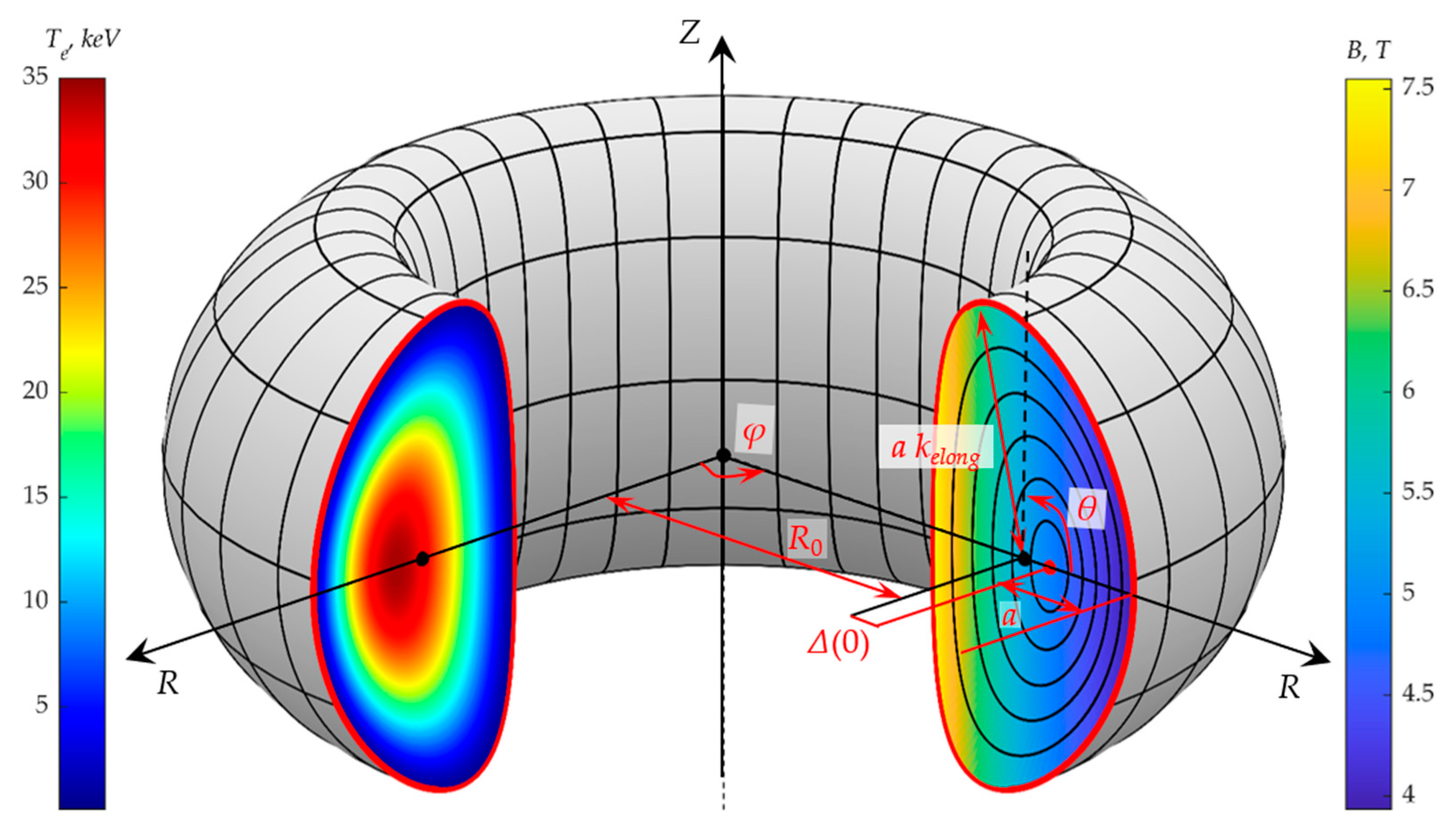
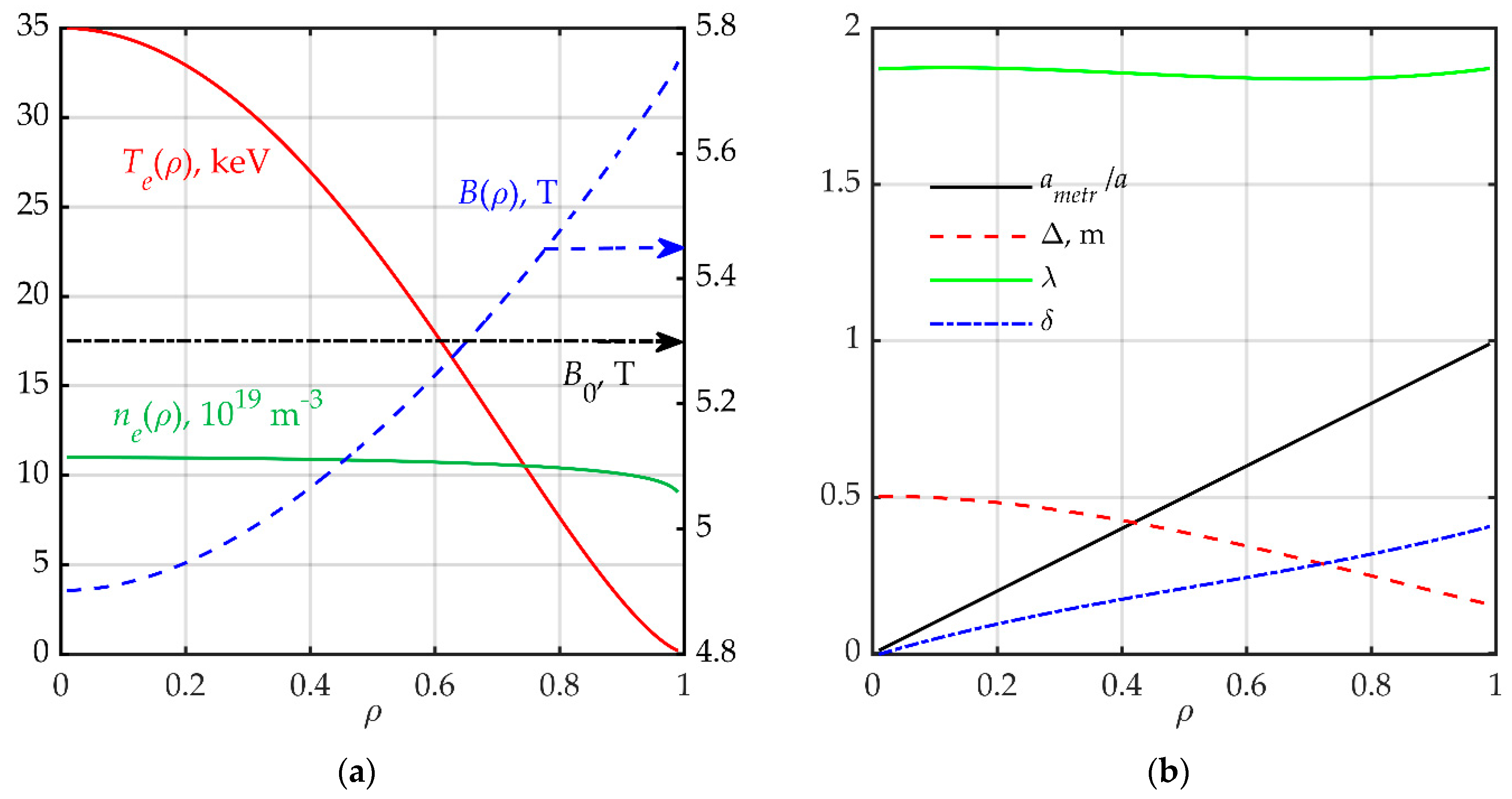
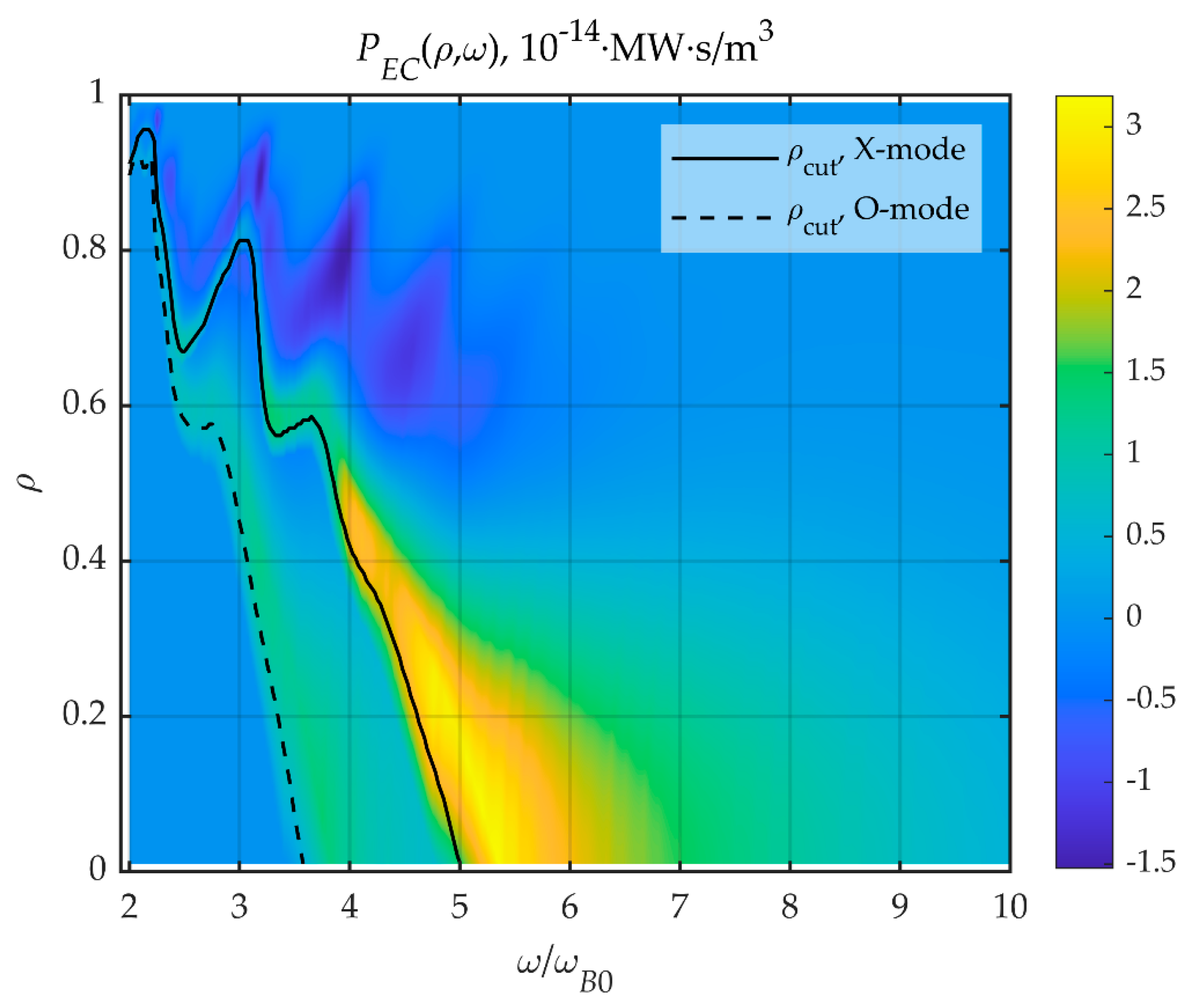
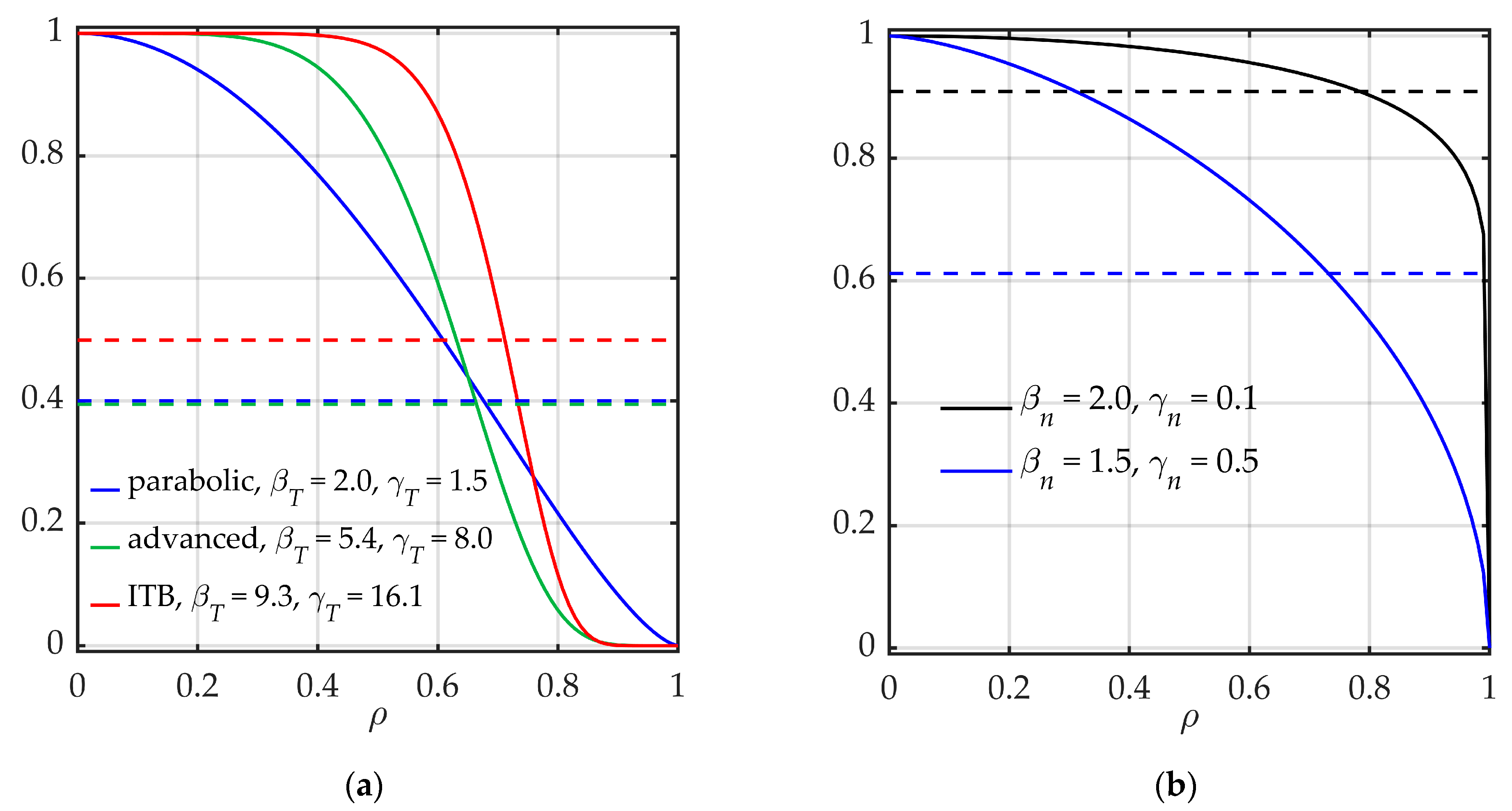
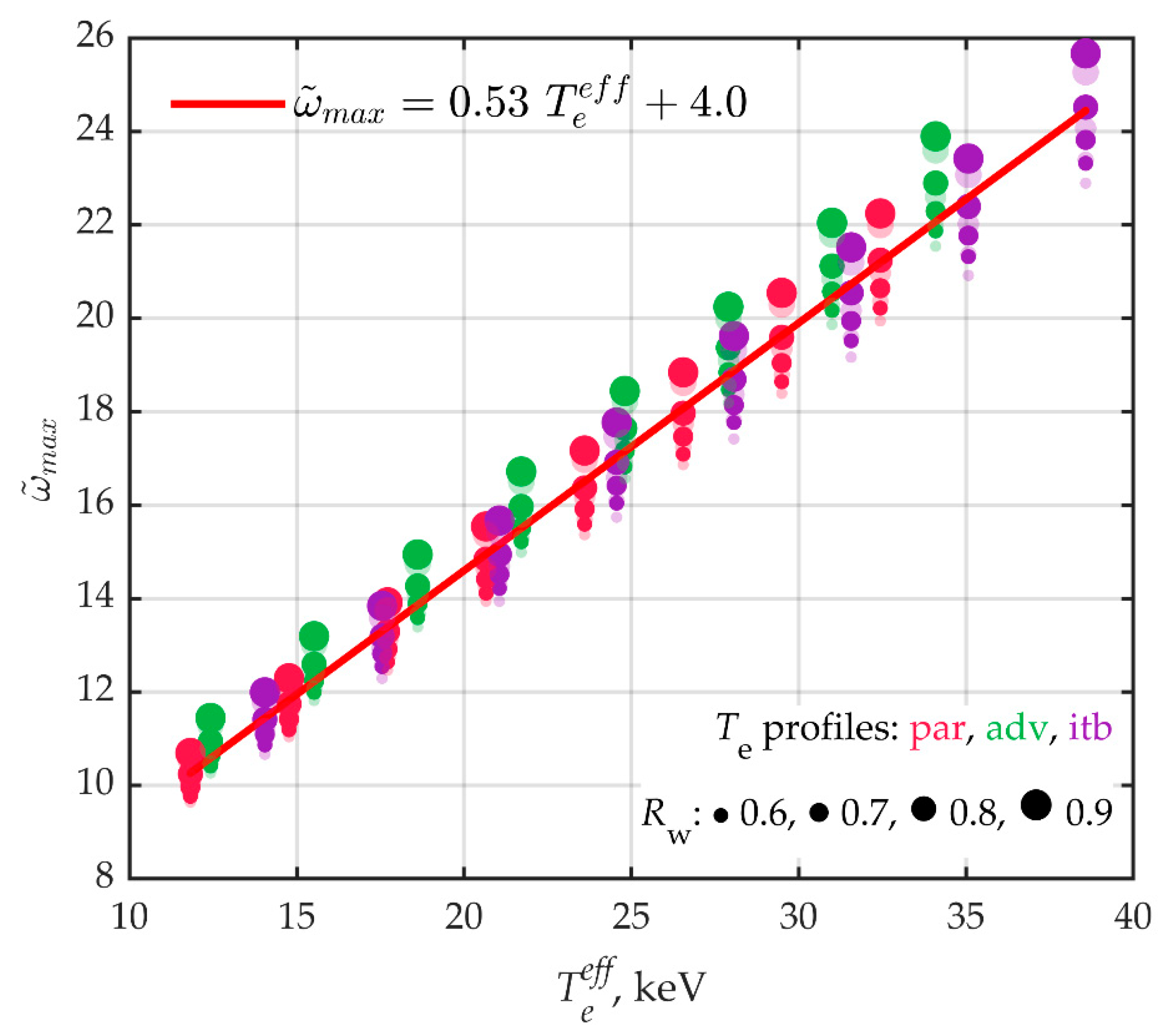
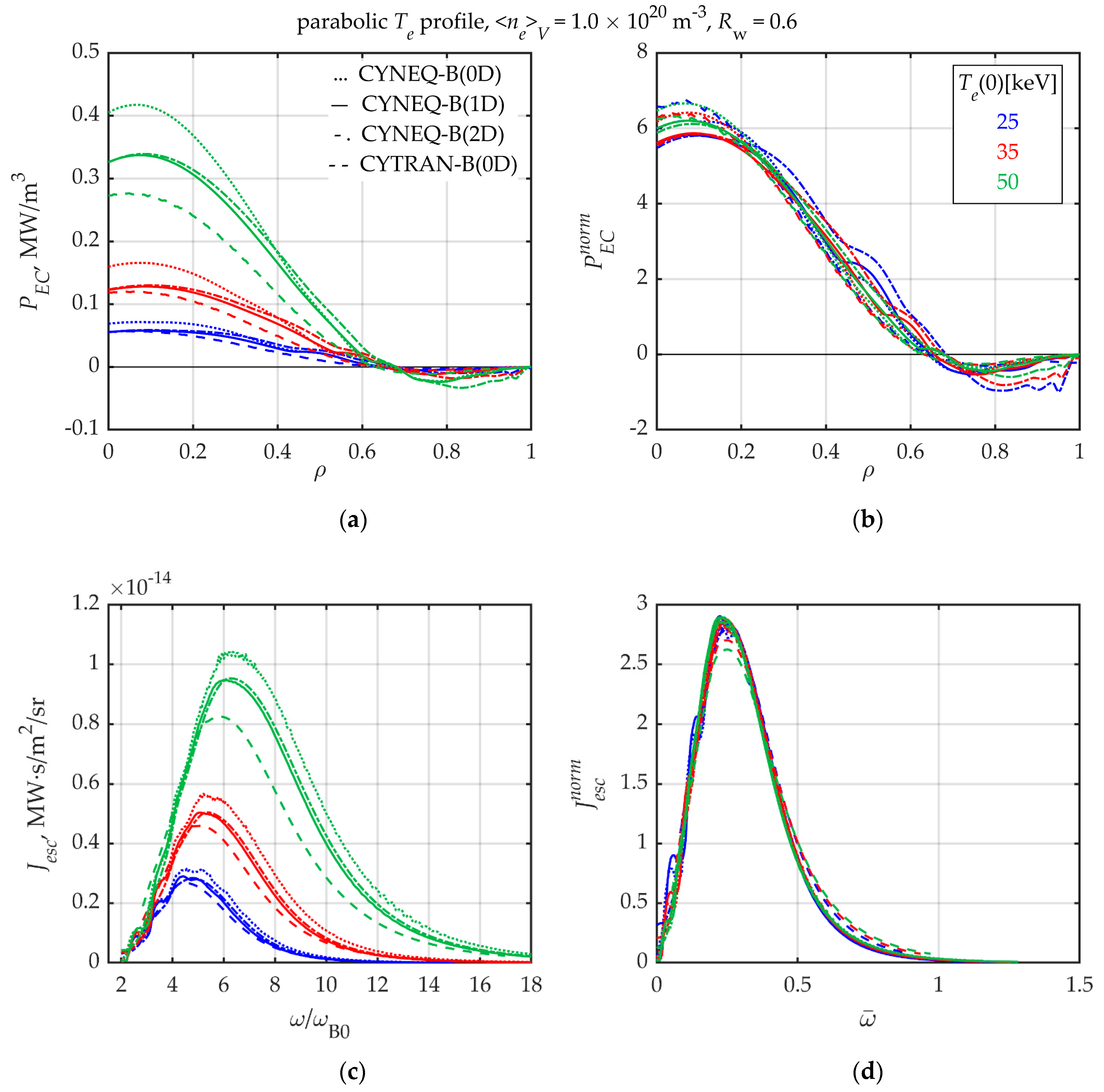
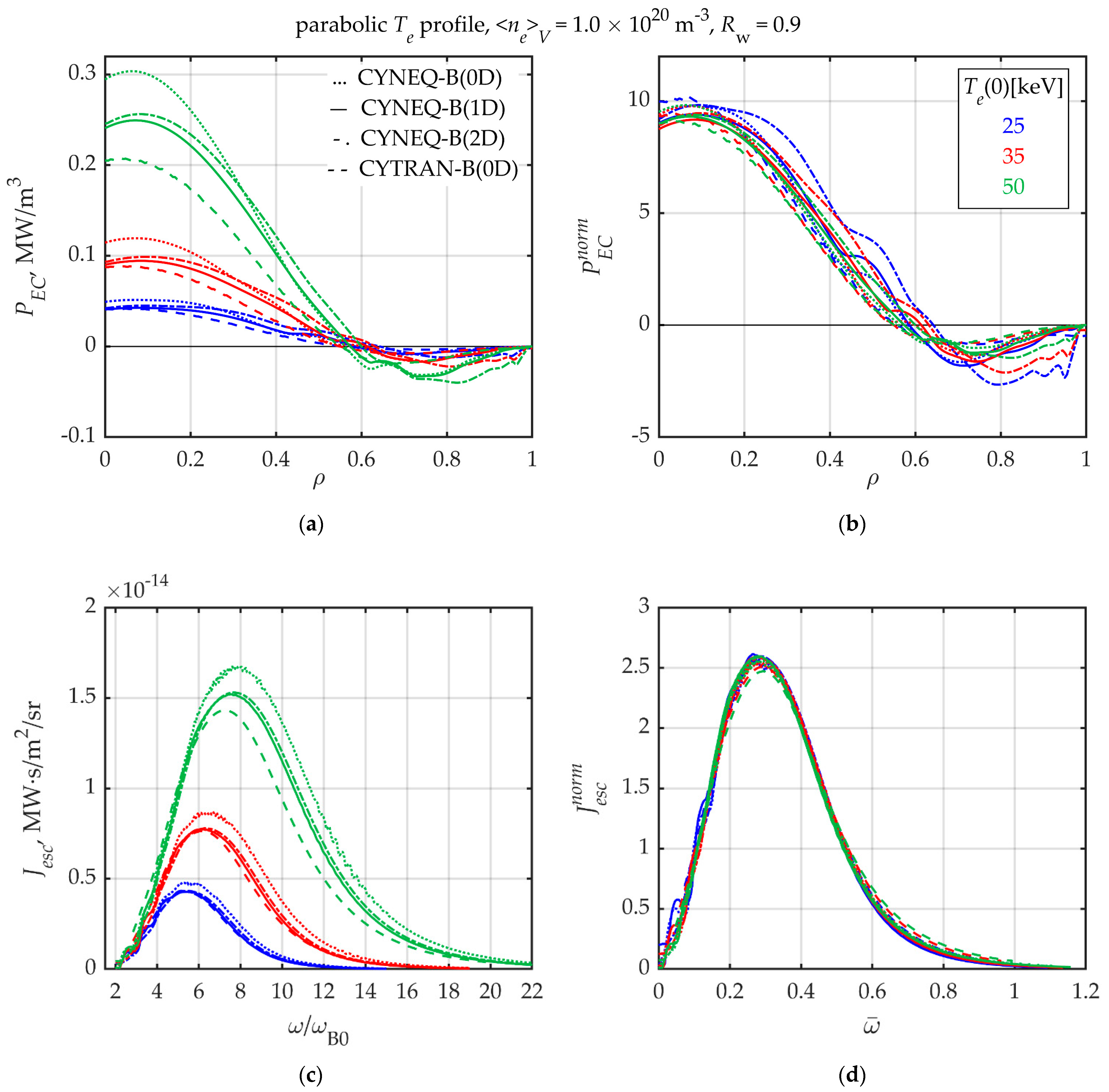



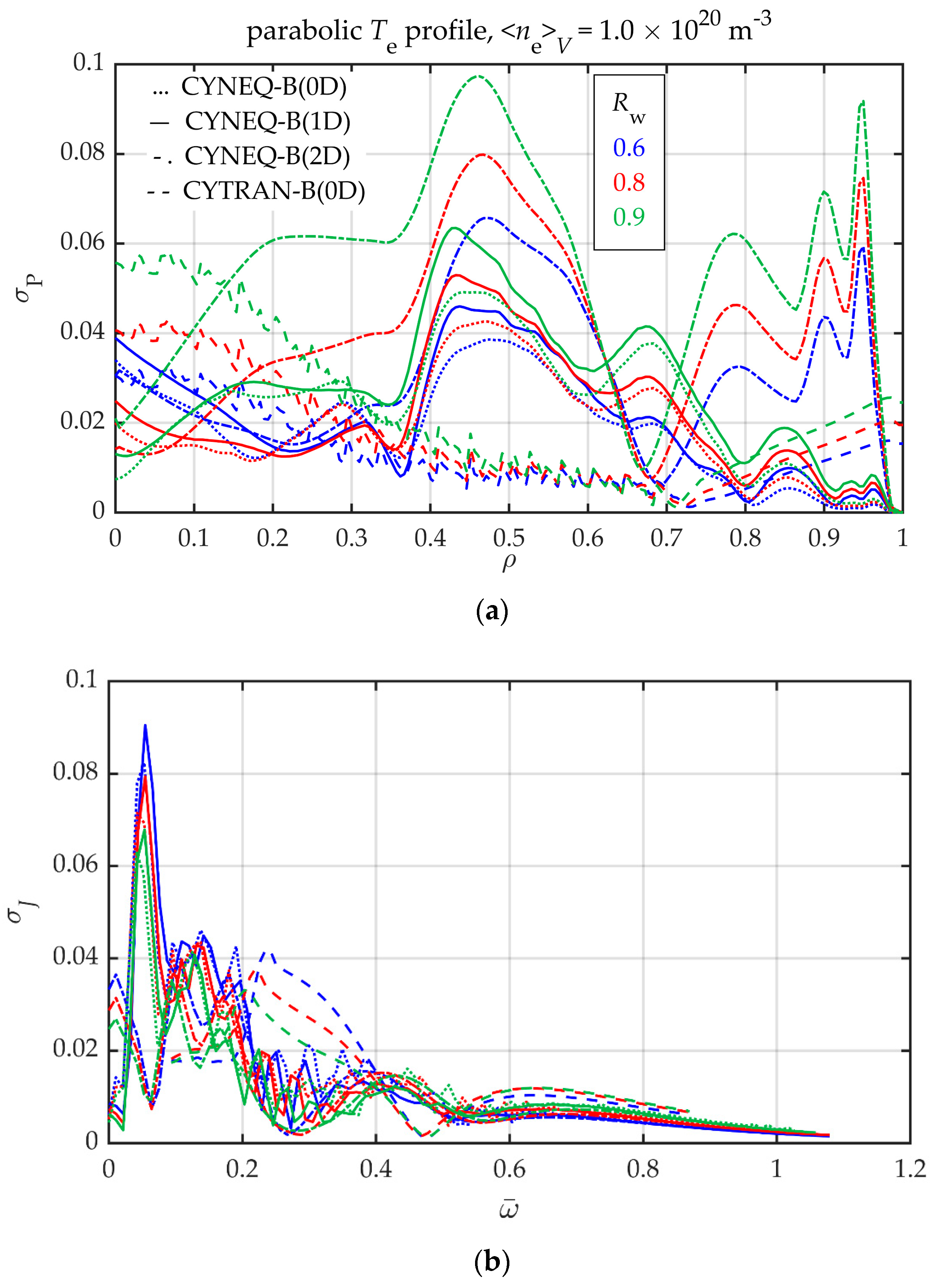
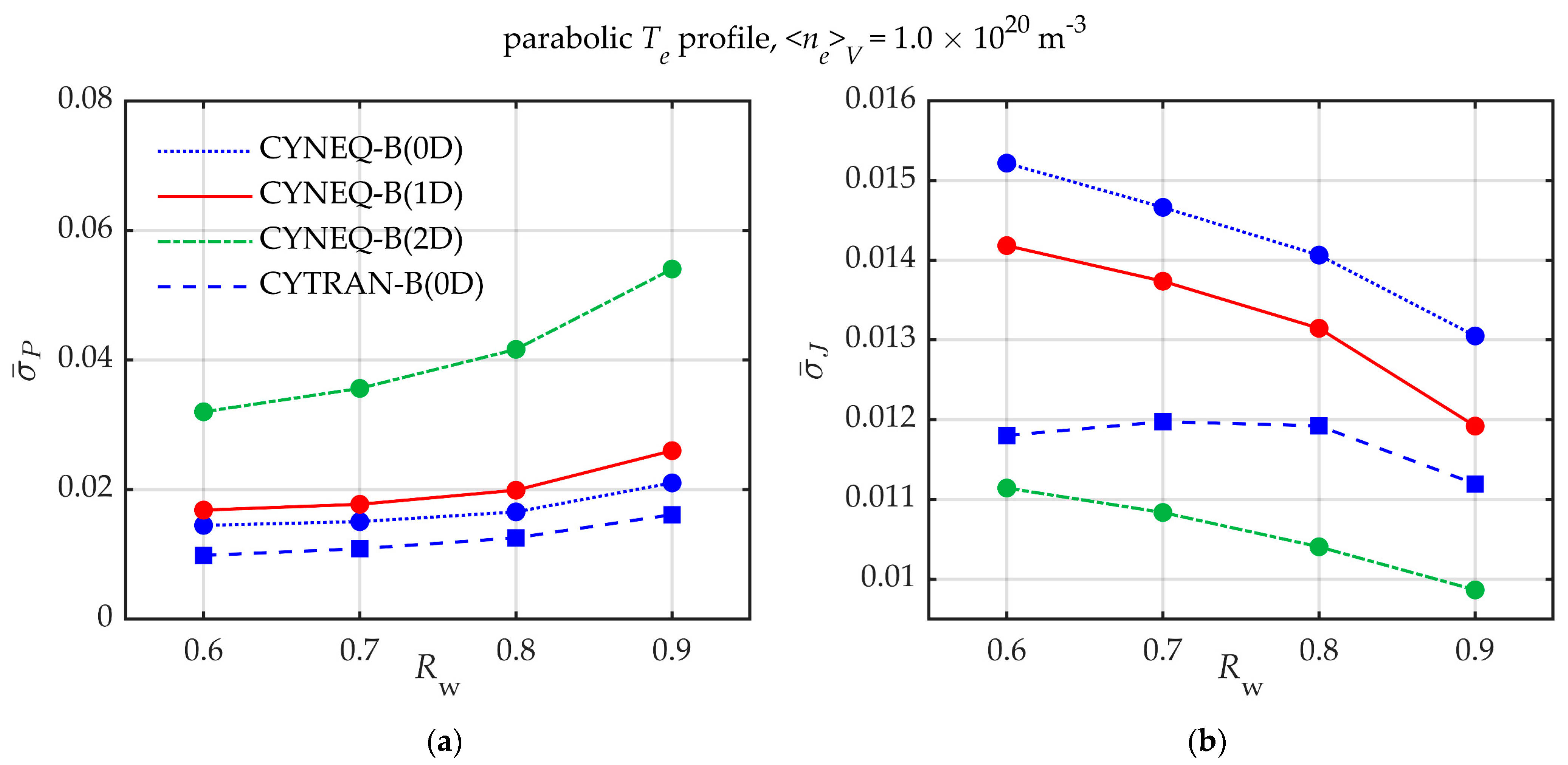
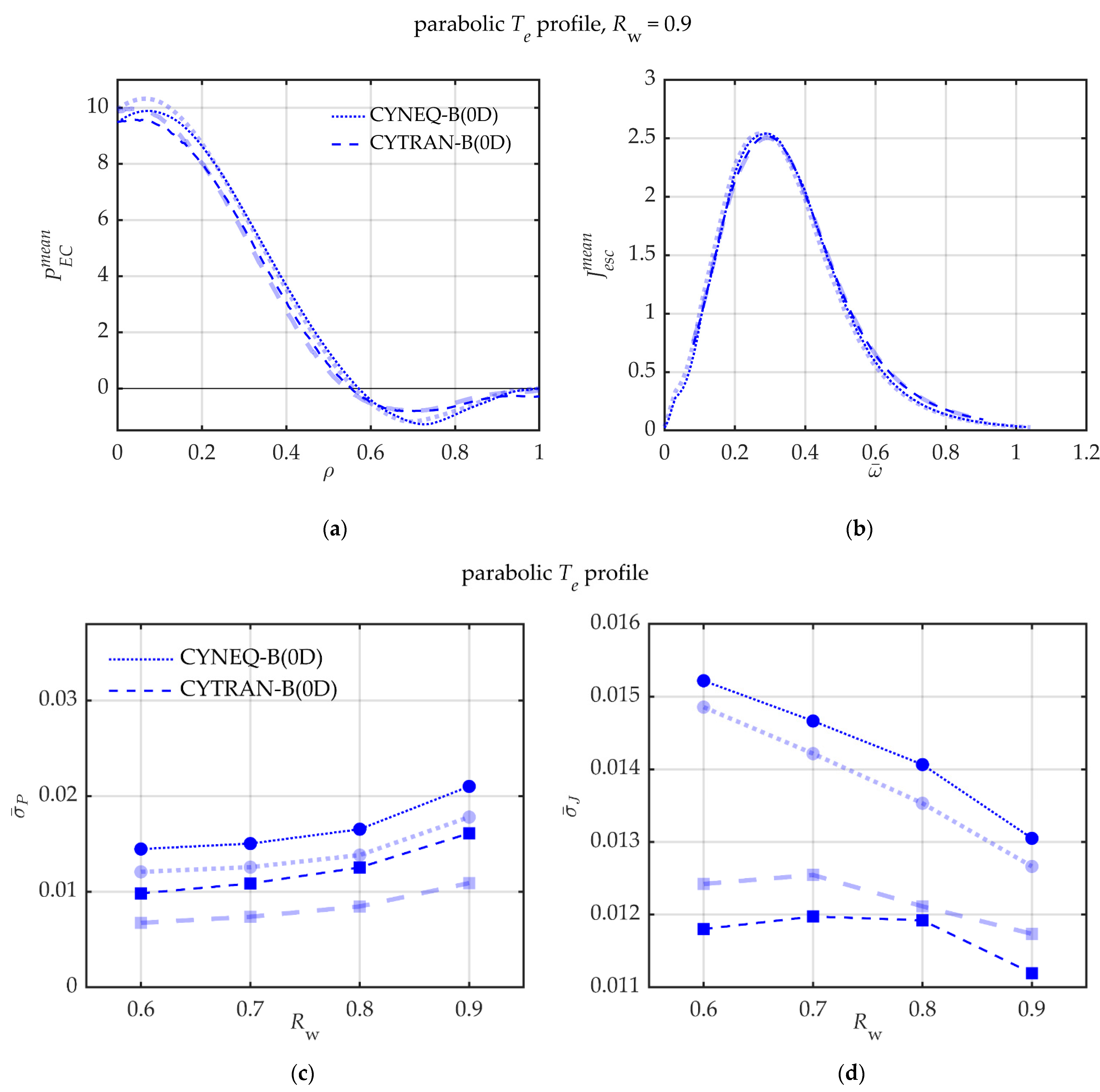
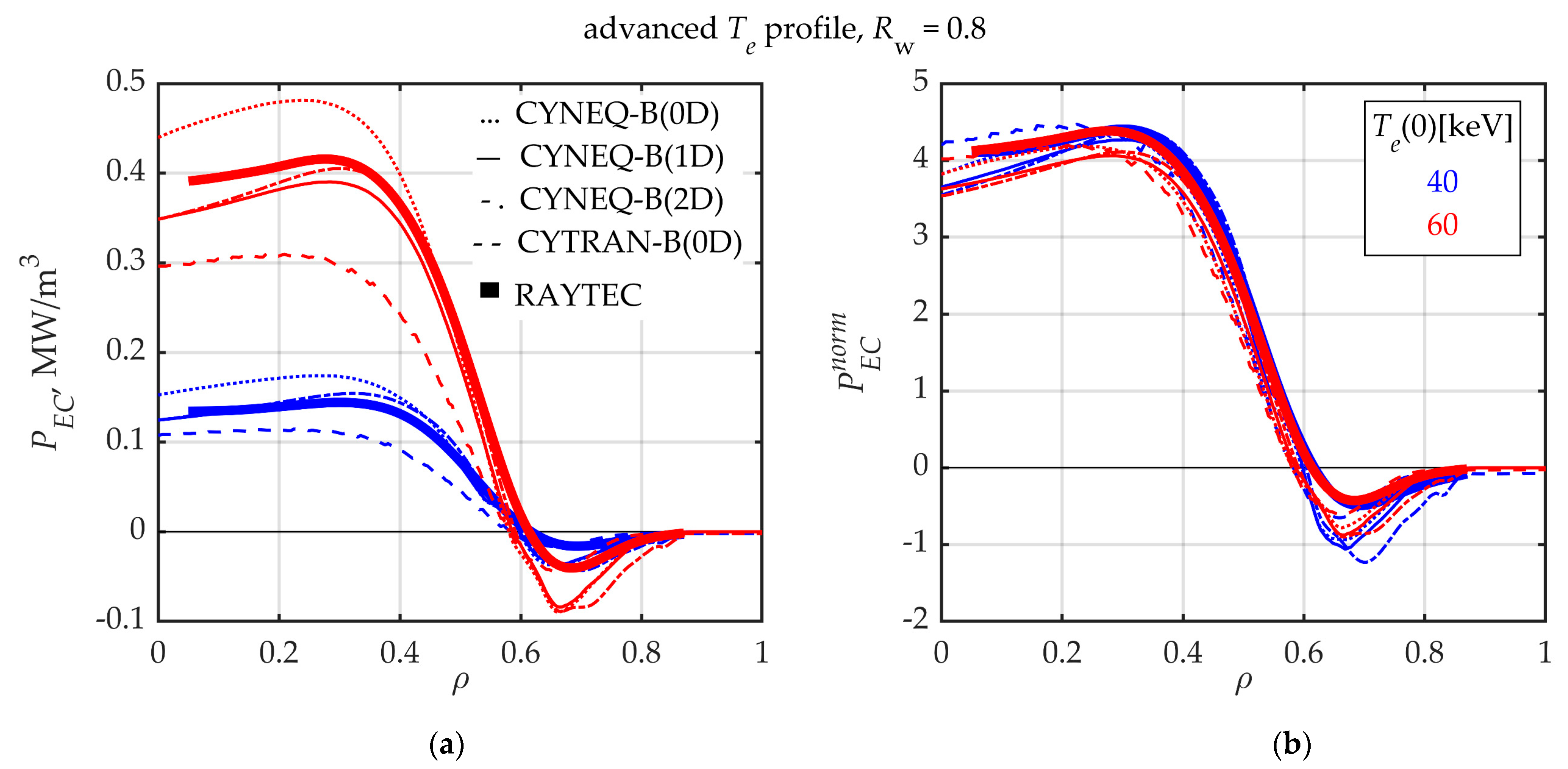
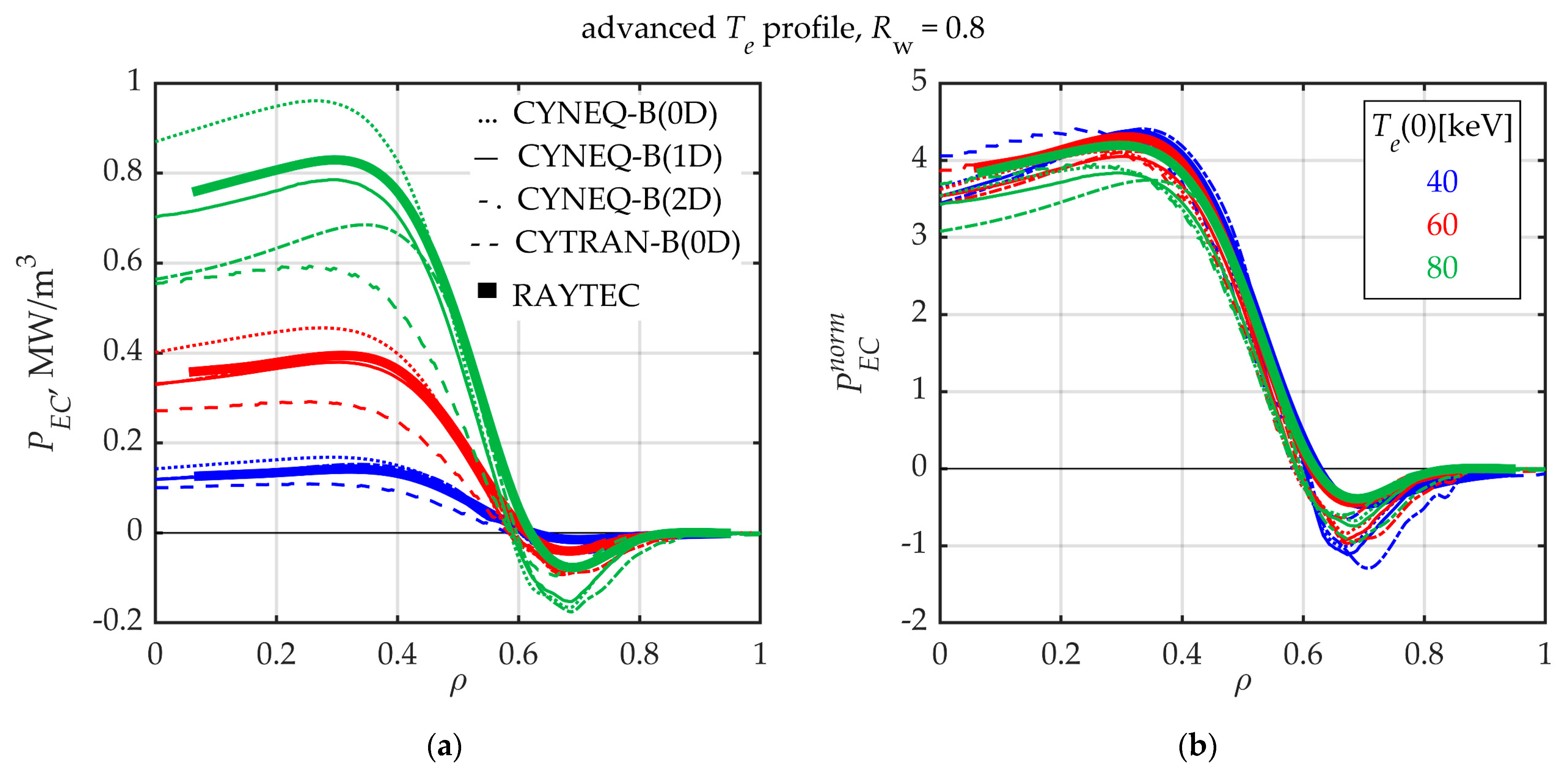
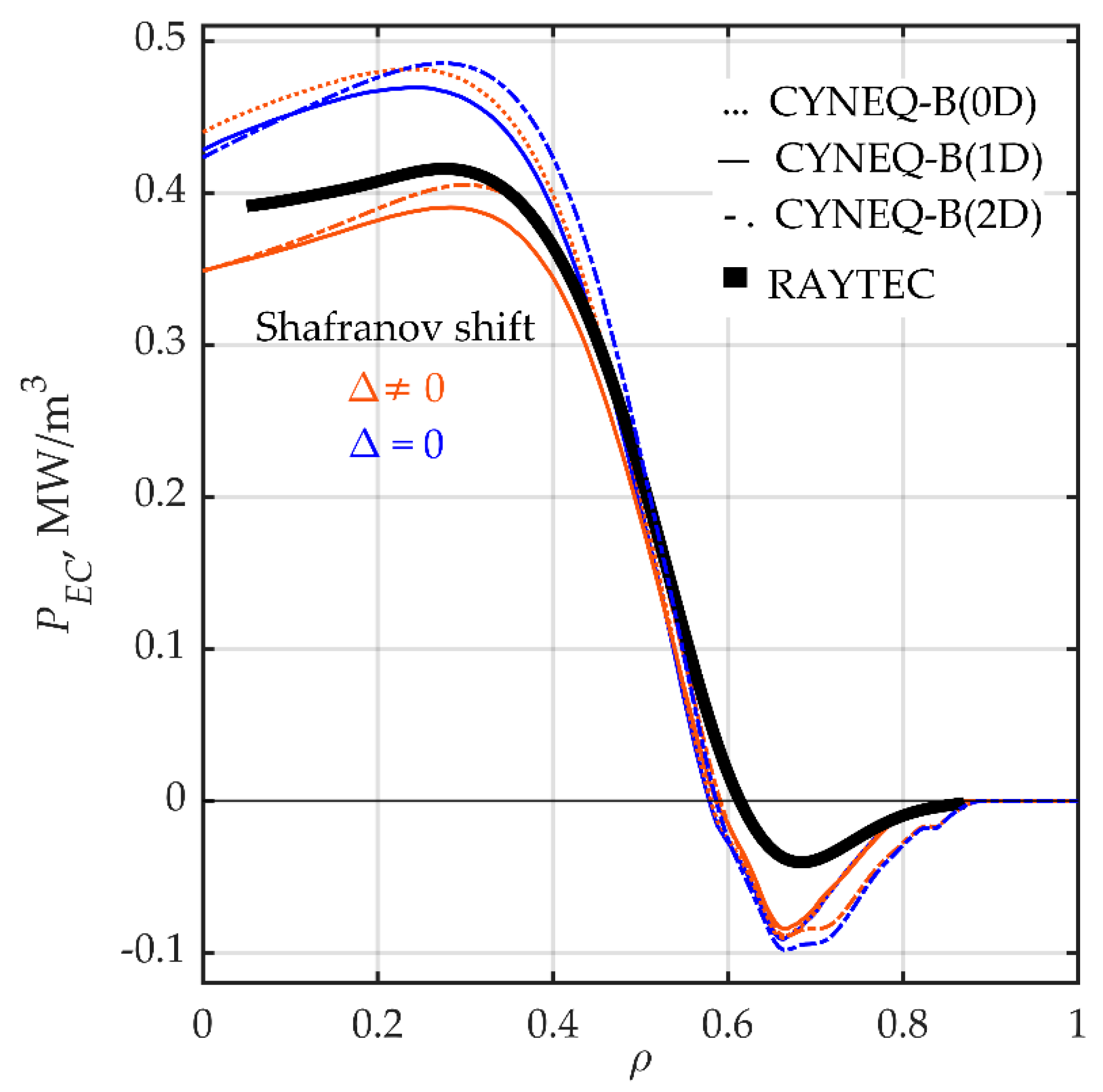
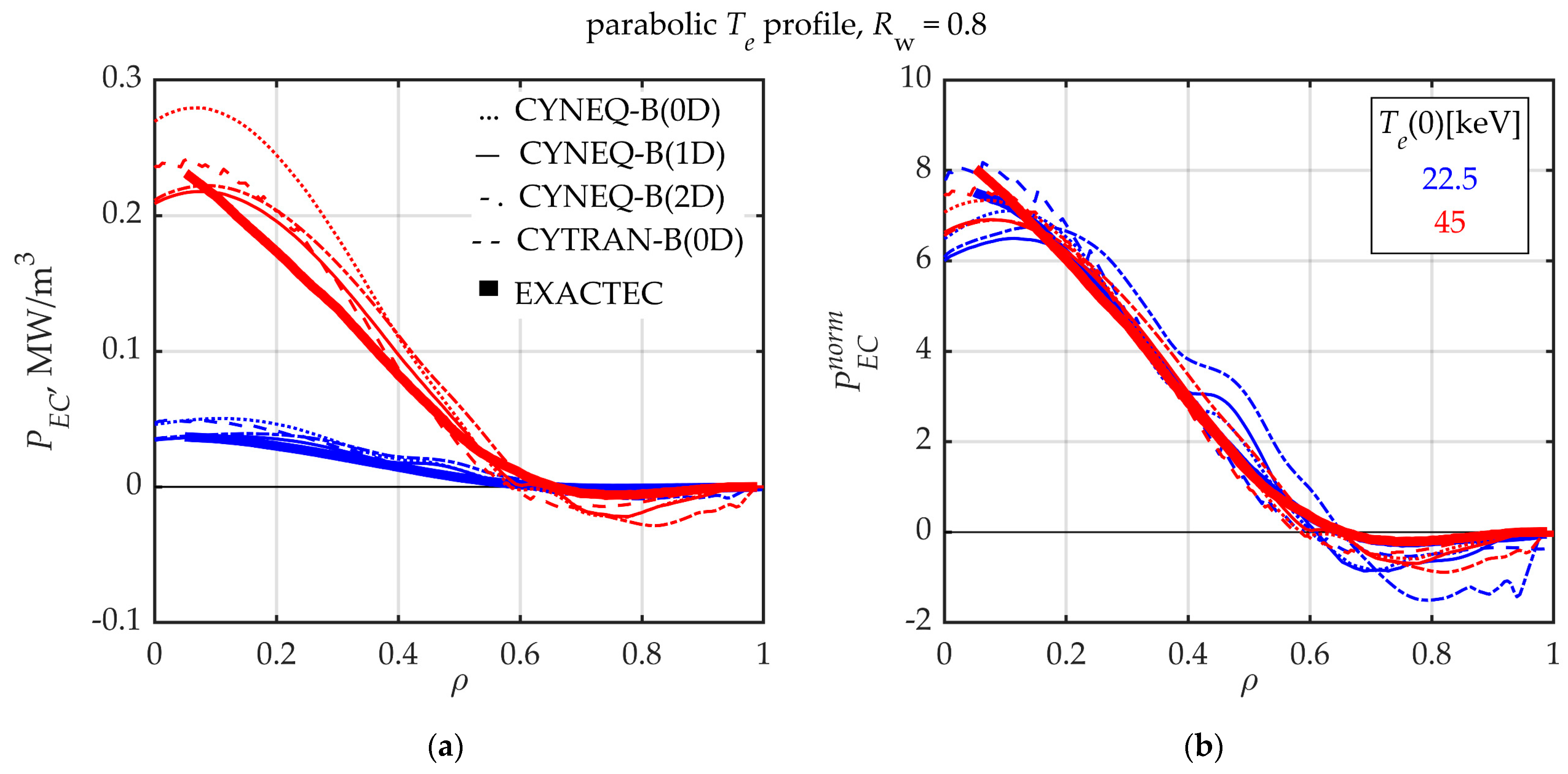

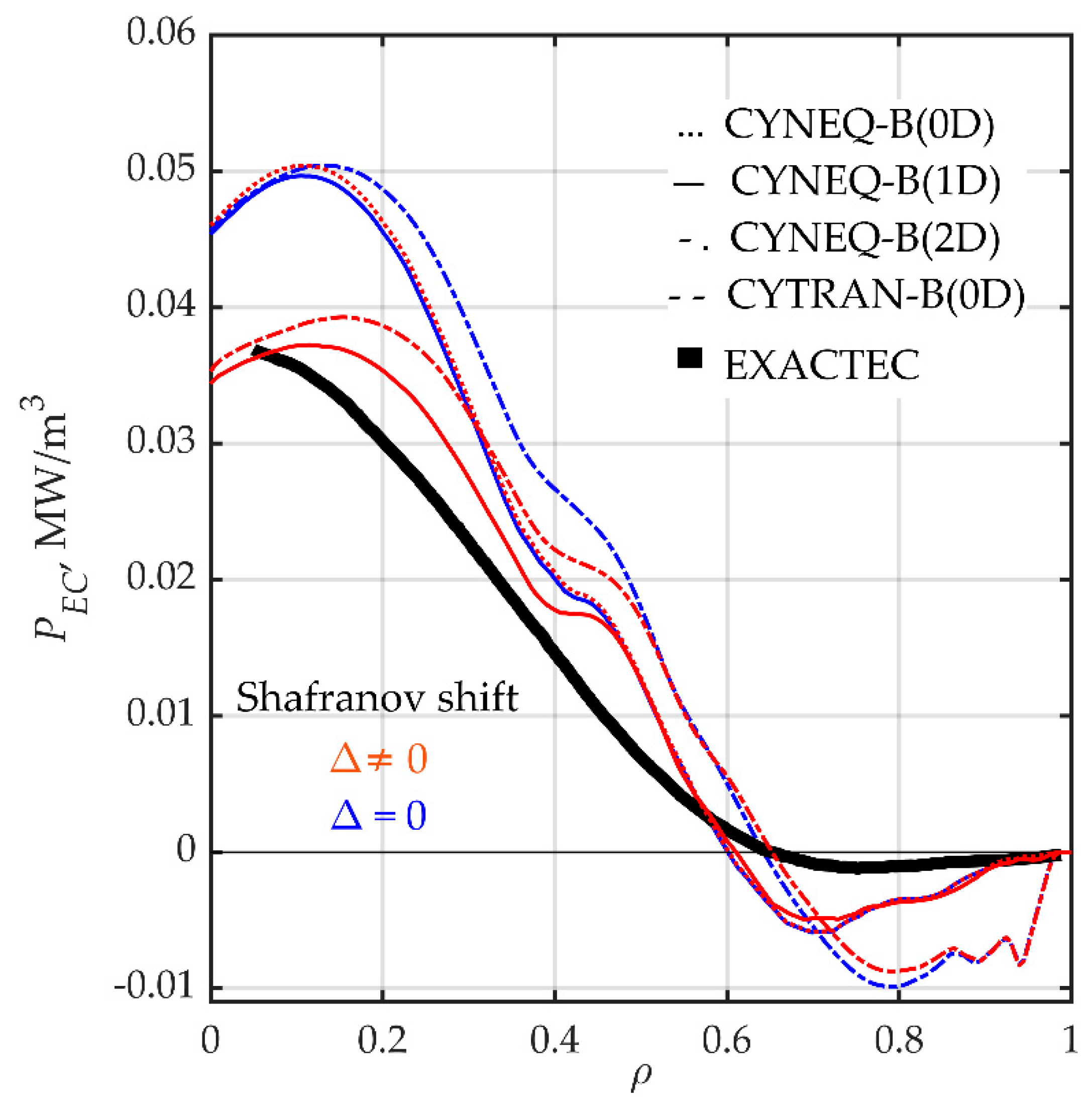
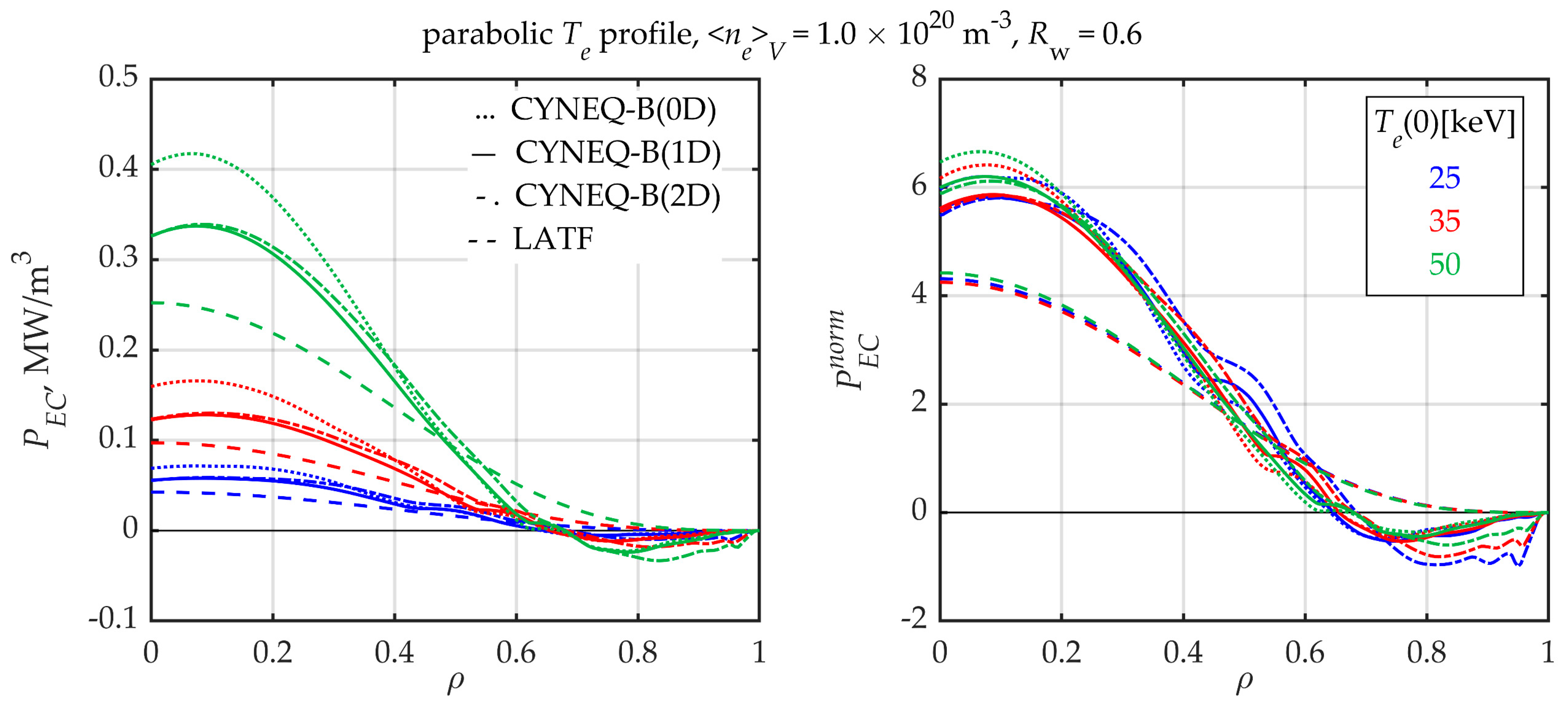
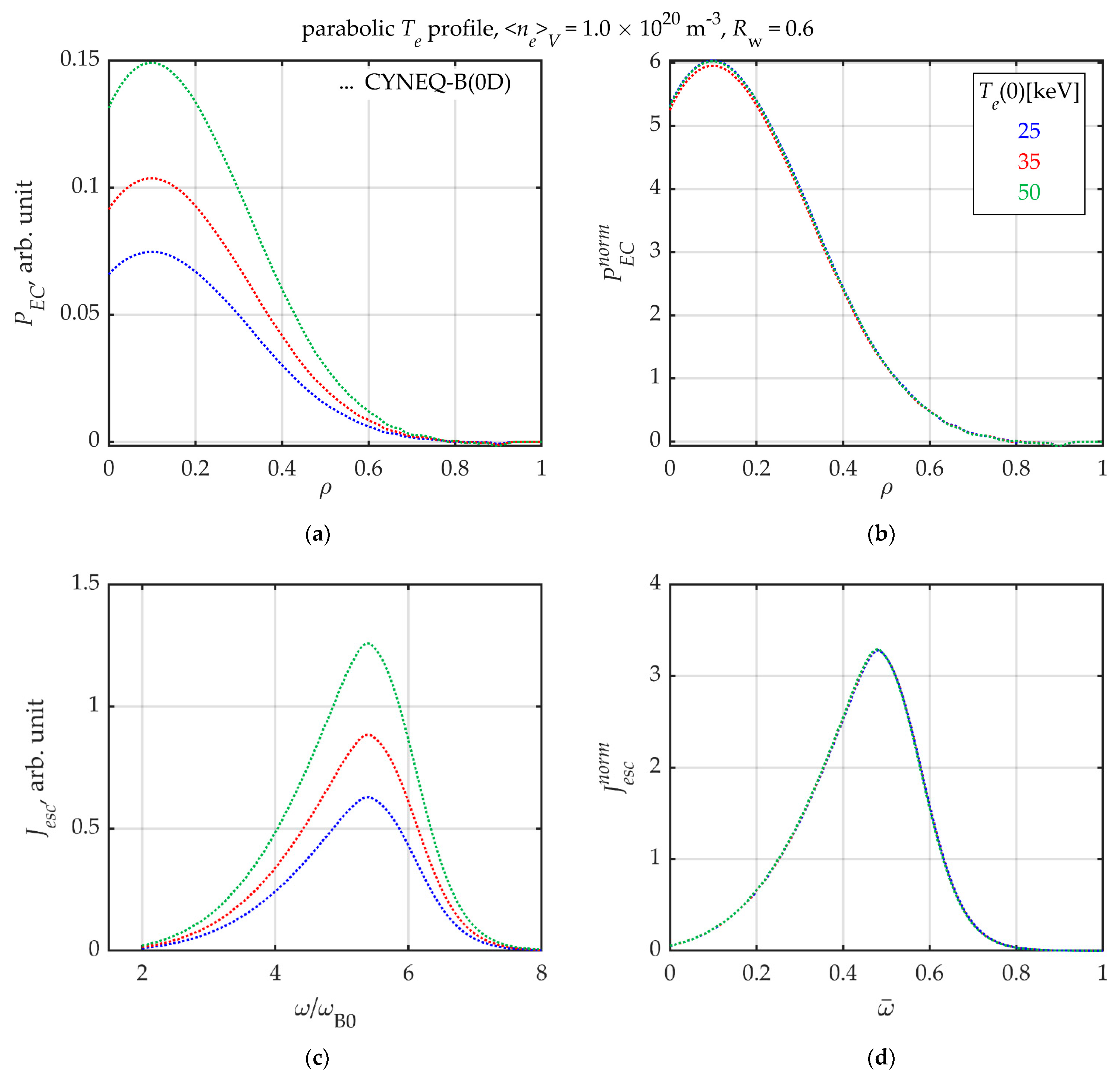
| Electron Temperature Profile | |||||||
|---|---|---|---|---|---|---|---|
| Edge and Central Values | Parabolic | Advanced | ITB | ||||
| βT = 2.0, γT = 1.5 | βT = 5.4, γT = 8.0 | βT = 9.3, γT = 16.1 | |||||
| Te(1), keV | Te(0), keV | <Te>V, keV | , keV | <Te>V, keV | , keV | <Te>V, keV | , keV |
| 0.01 | 20 | 8.0 | 11.8 | 8.0 | 12.4 | 10.0 | 14.0 |
| 25 | 10.0 | 14.7 | 10.0 | 15.5 | 12.5 | 17.5 | |
| 30 | 12.0 | 17.7 | 12.0 | 18.6 | 15.0 | 21.0 | |
| 35 | 14.0 | 20.6 | 14.0 | 21.7 | 17.5 | 24.5 | |
| 40 | 16.0 | 23.6 | 16.0 | 24.8 | 20.0 | 28.0 | |
| 45 | 18.0 | 26.5 | 18.0 | 27.9 | 22.5 | 31.5 | |
| 50 | 20.0 | 29.5 | 20.0 | 31.0 | 25.0 | 35.0 | |
| 55 | 22.0 | 32.4 | 22.0 | 34.1 | 27.4 | 38.5 | |
| Flat Profile | Non-Flat Profile | |
|---|---|---|
| βn = 2.0, γn = 0.1 | βn = 1.5, γn = 0.5 | |
| ne(0), 1020 m−3 | 1.10 | 1.00 |
| ne(1), 1020 m−3 | 0.50 | 0.10 |
| <ne>V, 1020 m−3 | 1.05 | 0.65 |
| , 1020 m−3 | 1.07 | 0.77 |
| Te profile | Rw | Te(0), keV | |||||||||||
|---|---|---|---|---|---|---|---|---|---|---|---|---|---|
| 25 | 35 | 50 | |||||||||||
| PEC, MW | |||||||||||||
| CYNEQ | CYTRAN | CYNEQ | CYTRAN | CYNEQ | CYTRAN | ||||||||
| 0D | 1D | 2D | 0D | 0D | 1D | 2D | 0D | 0D | 1D | 2D | 0D | ||
| parabolic | 0.6 | 10.5 | 9.1 | 9.2 | 7.3 | 23.5 | 19.9 | 20.2 | 16.0 | 57.0 | 49.5 | 50.5 | 37.3 |
| 0.7 | 9.0 | 7.7 | 7.9 | 6.3 | 20.3 | 17.1 | 17.4 | 14.0 | 49.6 | 43.0 | 43.9 | 32.8 | |
| 0.8 | 7.2 | 6.2 | 6.3 | 5.1 | 16.3 | 13.8 | 14.0 | 11.5 | 40.5 | 35.1 | 35.8 | 27.3 | |
| 0.9 | 4.8 | 4.1 | 4.2 | 3.5 | 11.1 | 9.4 | 9.5 | 8.0 | 28.1 | 24.4 | 24.8 | 19.4 | |
| advanced | 0.6 | 14.9 | 13.0 | 13.4 | 10.1 | 33.8 | 28.8 | 29.7 | 22.9 | 83.3 | 72.6 | 74.8 | 54.8 |
| 0.7 | 12.7 | 11.1 | 11.5 | 8.8 | 29.1 | 24.8 | 25.6 | 20.0 | 72.5 | 63.2 | 65.1 | 48.3 | |
| 0.8 | 10.2 | 8.9 | 9.2 | 7.2 | 23.4 | 20.0 | 20.7 | 16.5 | 59.2 | 51.6 | 53.2 | 40.2 | |
| 0.9 | 6.8 | 5.9 | 6.1 | 4.9 | 15.9 | 13.6 | 14.1 | 11.5 | 41.3 | 35.9 | 37.1 | 28.7 | |
| ITB | 0.6 | 18.6 | 16.7 | 17.6 | 12.2 | 42.7 | 37.5 | 39.4 | 27.8 | 106.5 | 95.5 | 99.7 | 67.6 |
| 0.7 | 15.9 | 14.2 | 15.0 | 10.6 | 36.7 | 32.2 | 33.9 | 24.3 | 92.3 | 82.8 | 86.6 | 59.6 | |
| 0.8 | 12.6 | 11.3 | 12.0 | 8.6 | 29.4 | 25.8 | 27.2 | 19.9 | 75.1 | 67.4 | 70.5 | 49.4 | |
| 0.9 | 8.4 | 7.5 | 8.0 | 5.9 | 19.9 | 17.5 | 18.5 | 13.9 | 52.0 | 46.7 | 48.9 | 35.2 | |
Publisher’s Note: MDPI stays neutral with regard to jurisdictional claims in published maps and institutional affiliations. |
© 2021 by the authors. Licensee MDPI, Basel, Switzerland. This article is an open access article distributed under the terms and conditions of the Creative Commons Attribution (CC BY) license (https://creativecommons.org/licenses/by/4.0/).
Share and Cite
Kukushkin, A.B.; Minashin, P.V. Self-Similarity of Continuous-Spectrum Radiative Transfer in Plasmas with Highly Reflecting Walls. Symmetry 2021, 13, 1303. https://doi.org/10.3390/sym13071303
Kukushkin AB, Minashin PV. Self-Similarity of Continuous-Spectrum Radiative Transfer in Plasmas with Highly Reflecting Walls. Symmetry. 2021; 13(7):1303. https://doi.org/10.3390/sym13071303
Chicago/Turabian StyleKukushkin, Alexander B., and Pavel V. Minashin. 2021. "Self-Similarity of Continuous-Spectrum Radiative Transfer in Plasmas with Highly Reflecting Walls" Symmetry 13, no. 7: 1303. https://doi.org/10.3390/sym13071303
APA StyleKukushkin, A. B., & Minashin, P. V. (2021). Self-Similarity of Continuous-Spectrum Radiative Transfer in Plasmas with Highly Reflecting Walls. Symmetry, 13(7), 1303. https://doi.org/10.3390/sym13071303






